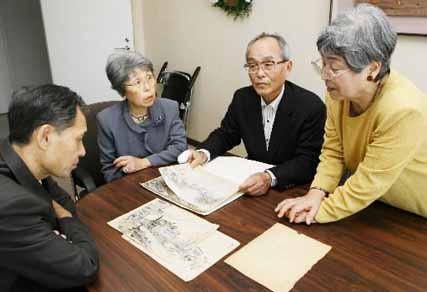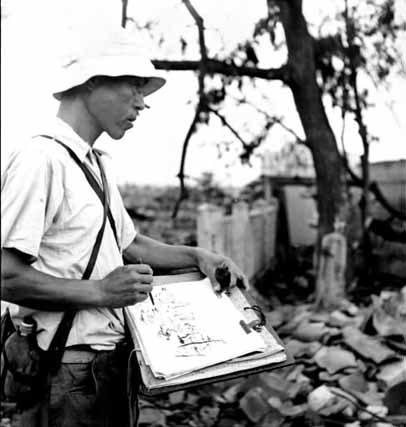Sketches made soon after the atomic bombing given to Peace Memorial Museum
Mar. 18, 2008
by Masami Nishimoto, Senior Staff Writer
Eighteen original sketches depicting the devastation of Hiroshima one month after the atomic bombing, drawn by the late Keiso Takamasu, a Japanese-style painter, were donated to Peace Memorial Museum by his family on March 11. Many were created on September 9, 1945 and are among the earliest A-bomb related drawings. On September 8, 1945, Mr. Takamasu was captured sketching in one of the photos taken by the U.S. Manhattan District Survey Team during its visit to Hiroshima to investigate residual radiation.
The sketches had been in the possession of Mr. Takamasu's eldest son, Fumio, 72, who lives in Chiba, near Tokyo. Accompanied by his younger sister, Akiko, 66, also of Chiba and a Japanese-style painter herself, and his older sister Utako Tamaru, 75, of Hiroshima, he came to Peace Memorial Museum and offered their father's sketches, entitled “A-bomb Sketches,” to Museum Director Koichiro Maeda. This donation was made on the occasion of Akiko's solo exhibition which opened on the same day at Sogo Department Store in downtown Hiroshima.
Their father, Keizo (“Keizo” was the original spelling of his name), was born in Tokyo and lost his hearing when he was a child. Later, he studied Japanese painting and became an art teacher at around age 25 at the former Hiroshima Prefectural School for the Deaf. In April 1945, close to the end of World War II, the school was evacuated to a site 45 kilometers northeast of the city and so the family moved to that location, too.
One of the 18 sketches depicts the huge mushroom cloud rising beyond the mountains. Mr. Takamasu made this sketch with a pencil on August 6, 1945. The rest were created with ink and oil pastel on rough paper, revealing the terrible destruction in the vicinity of the hypocenter. These were sketched on September 9, 1945, one month after the bombing, when Mr. Takamasu went into the city center with Fumio as his interpreter. It was then that the American survey team took his picture.
Fumio recalled standing amid the ruins and commented, “I felt frightened when the U.S army approached us.” He also shared his feelings in relation to donating the sketches, saying, “My father made these sketches because he felt it was imperative to record the reality of the bombing for the future. One of my sisters became a painter, like my father, and I thought it would be fitting, alongside her exhibition in Hiroshima, to give these sketches to the city so they can be seen by many people.”
Mr. Takamasu's children added, “By donating his sketches, we feel like we're sharing an important part of our father.” Mr. Maeda, promising to preserve and make good use of the valuable A-bomb pictures, responded, “These sketches, made right after the atomic bombing, have such authenticity--as if even the smell of the bombing could be detected.”
Eighteen original sketches depicting the devastation of Hiroshima one month after the atomic bombing, drawn by the late Keiso Takamasu, a Japanese-style painter, were donated to Peace Memorial Museum by his family on March 11. Many were created on September 9, 1945 and are among the earliest A-bomb related drawings. On September 8, 1945, Mr. Takamasu was captured sketching in one of the photos taken by the U.S. Manhattan District Survey Team during its visit to Hiroshima to investigate residual radiation.
The sketches had been in the possession of Mr. Takamasu's eldest son, Fumio, 72, who lives in Chiba, near Tokyo. Accompanied by his younger sister, Akiko, 66, also of Chiba and a Japanese-style painter herself, and his older sister Utako Tamaru, 75, of Hiroshima, he came to Peace Memorial Museum and offered their father's sketches, entitled “A-bomb Sketches,” to Museum Director Koichiro Maeda. This donation was made on the occasion of Akiko's solo exhibition which opened on the same day at Sogo Department Store in downtown Hiroshima.
Their father, Keizo (“Keizo” was the original spelling of his name), was born in Tokyo and lost his hearing when he was a child. Later, he studied Japanese painting and became an art teacher at around age 25 at the former Hiroshima Prefectural School for the Deaf. In April 1945, close to the end of World War II, the school was evacuated to a site 45 kilometers northeast of the city and so the family moved to that location, too.
One of the 18 sketches depicts the huge mushroom cloud rising beyond the mountains. Mr. Takamasu made this sketch with a pencil on August 6, 1945. The rest were created with ink and oil pastel on rough paper, revealing the terrible destruction in the vicinity of the hypocenter. These were sketched on September 9, 1945, one month after the bombing, when Mr. Takamasu went into the city center with Fumio as his interpreter. It was then that the American survey team took his picture.
Fumio recalled standing amid the ruins and commented, “I felt frightened when the U.S army approached us.” He also shared his feelings in relation to donating the sketches, saying, “My father made these sketches because he felt it was imperative to record the reality of the bombing for the future. One of my sisters became a painter, like my father, and I thought it would be fitting, alongside her exhibition in Hiroshima, to give these sketches to the city so they can be seen by many people.”
Mr. Takamasu's children added, “By donating his sketches, we feel like we're sharing an important part of our father.” Mr. Maeda, promising to preserve and make good use of the valuable A-bomb pictures, responded, “These sketches, made right after the atomic bombing, have such authenticity--as if even the smell of the bombing could be detected.”









